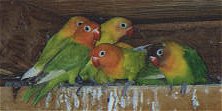

Set Up
Same Species Colonies
Mixed Colonies
Semi-Colony Species
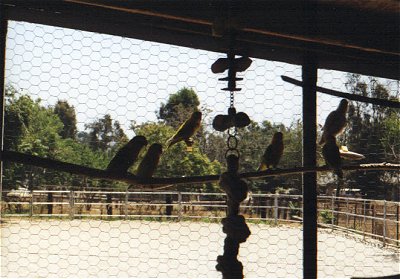 Colony breeding is something that is best done in an aviary. Nestboxes should obviously be
provided for each pair but you should also throw in 2-3 extra so the birds can have their pick.
Unused boxes can always be removed once everyone has settled in. Several feed stations and water
dishes should be placed in various locations to avoid fights. Never place one nestbox or perch
higher than the others because everyone will want to use it. Nestboxes should all be at the same
height. Perches can vary in height as long as there are more than one "highest perch."
Colony breeding is something that is best done in an aviary. Nestboxes should obviously be
provided for each pair but you should also throw in 2-3 extra so the birds can have their pick.
Unused boxes can always be removed once everyone has settled in. Several feed stations and water
dishes should be placed in various locations to avoid fights. Never place one nestbox or perch
higher than the others because everyone will want to use it. Nestboxes should all be at the same
height. Perches can vary in height as long as there are more than one "highest perch."
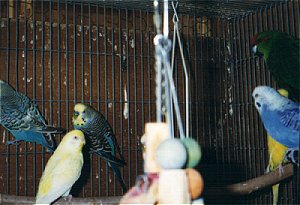 Feed
Feed
Keep in mind that you'll be feeding a single diet. Birds that require special foods should not
be kept in a colony. Likewise, if you have some picky birds or seed junkies you'll have to feed
seed. You can try offering pellets in hopes that your junkies will learn to eat them from your
other birds. However, even pellet eaters will usually eat seed instead of pellets if they are
provided. The good news is that everyone learns to eat soft foods very quickly.
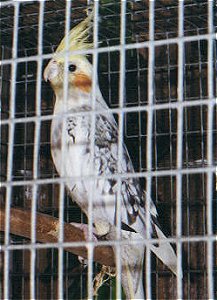 Non-Breeding Colony
Non-Breeding Colony
Follow the instructions for picking mixed flight species. Some birds are only aggressive during
breeding and many different species of some size variation can be kept safely when there are no
nestboxes provided. Retailers often keep birds for sale in such a set up. These work well
because no one is interested in breeding and since birds are coming and going all the time no one
has time to establish territory.
The best same species colony is one containing budgies. In fact, budgies are the one species that
breeds best in colonies. Keep in mind that with this type of colony you'll get a lot of cheating
between pairs. If you want strict control of your bloodlines this set up is not for you. I
personally don't like this type of colony because most birds that can
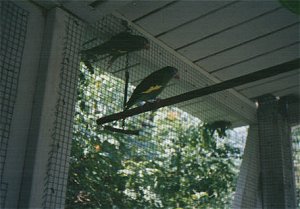 be bred in it can also be
bred in a mixed one.
be bred in it can also be
bred in a mixed one.
This is how I breed. Most of the Australian keets like budgies, cockatiels and Neophema
can coexist fine with similar species. Very closely related species shouldn't be kept together
to prevent hybridization. The trick to a mixed colony is keeping birds of similar size and
temperment. You want calm, small birds that aren't likely to pick fights with their neighbors.
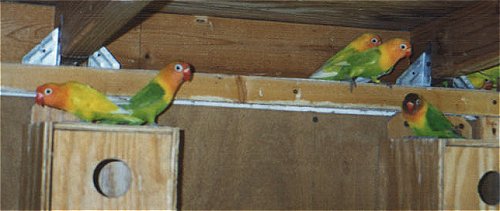 Some birds can be bred in same species colonies only if the cage is very large.
These birds should always be watched very closely and pulled out at the first sign of real
aggression. Birds that fall into this category are Brotogeris, some lovebirds
(Fischers usually do okay in colonies),
and some conures (Patagonian).
Some birds can be bred in same species colonies only if the cage is very large.
These birds should always be watched very closely and pulled out at the first sign of real
aggression. Birds that fall into this category are Brotogeris, some lovebirds
(Fischers usually do okay in colonies),
and some conures (Patagonian).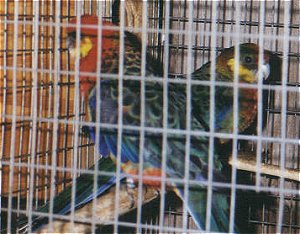 Aggressive Species
Aggressive Species
Some birds just can't be bred in colonies. These birds may be fine in a non-breeding colony but
will become very aggressive towards any other birds when nesting. They may nip off toes (make
sure there they can't get to the birds in the cage next door), maim or kill. Aussie keets that
should be avoided are red-rumps and rosellas. Parrots are also a no no.

All articles and images contained on this site are © 1998, 1999 by Feisty Feathers unless otherwise noted and may not be reprinted or used in any way without the author's permission.